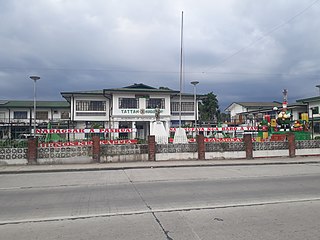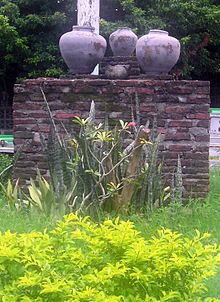
Ilocos Norte, officially the Province of Ilocos Norte, is a province of the Philippines located in the Ilocos Region. Its capital is Laoag City, located in the northwest corner of Luzon Island, bordering Cagayan and Apayao to the east, and Abra to the southeast, and Ilocos Sur to the southwest. Ilocos Norte faces the West Philippine Sea to the west and the Luzon Strait to the north.

Ilocos Sur, officially the Province of Ilocos Sur, is a province in the Philippines located in the Ilocos Region in Luzon. Located on the mouth of the Mestizo River is the capital of Vigan. Ilocos Sur is bordered by Ilocos Norte and Abra to the north, Mountain Province to the east, La Union and Benguet to the south and the South China Sea to the west.

La Union, officially the Province of La Union, is a province in the Philippines located in the Ilocos Region in the Island of Luzon. Its capital is the City of San Fernando, which also serves as the regional center of the Ilocos Region.

The Ilocos Region, designated as Region I, is an administrative region of the Philippines. Located in the northwestern section of Luzon, it is bordered by the Cordillera Administrative Region to the east, the Cagayan Valley to the northeast and southeast, Central Luzon to the south, and the South China Sea to the west.

Vigan, officially the City of Vigan, is a 4th class component city and capital of the province of Ilocos Sur, Philippines. According to the 2020 census, it has a population of 53,935 people.

Bagoóng is a Philippine condiment partially or completely made of either fermented fish or krill or shrimp paste with salt. The fermentation process also produces fish sauce known as patís.

San Nicolas, officially the Municipality of San Nicolas, is a 1st class municipality in the province of Ilocos Norte, Philippines. According to the 2020 census, it has a population of 38,895 people.

San Ildefonso, officially the Municipality of San Ildefonso, is a 5th class municipality in the province of Ilocos Sur, Philippines. According to the 2020 census, it has a population of 8,190 people.

Naguilian, officially the Municipality of Naguilian, is a 1st class municipality in the province of La Union, Philippines. According to the 2020 census, it has a population of 52,189 people.

The Ilocanos, Ilokanos, or Iloko people are the third largest Filipino ethnolinguistic group. They mostly reside within the Ilocos Region, in the northwestern seaboard of Luzon, Philippines. The native language of the Ilocano people is the Ilocano language.

During the Spanish colonial period in the Philippines, 1521–1898, there were several revolts against the Spanish colonial government by indigenous Moro, Lumad, Indios, Chinese (Sangleys), and Insulares, often with the goal of re-establishing the rights and powers that had traditionally belonged to Lumad communities, Maginoo Rajah, and Moro Datus. Some revolts stemmed from land problems and this was largely the cause of the insurrections that transpired in the agricultural provinces of Batangas, Bulacan, Cavite, and Laguna. Natives also rebelled over unjust taxation and forced labor.

Tapai is a traditional fermented preparation of rice or other starchy foods, and is found throughout much of Southeast Asia, especially in Austronesian cultures, and parts of East Asia. It refers to both the alcoholic paste and the alcoholic beverage derived from it. It has a sweet or sour taste and can be eaten as is, as ingredients for traditional recipes, or fermented further to make rice wine. Tapai is traditionally made with white rice or glutinous rice, but can also be made from a variety of carbohydrate sources, including cassava and potatoes. Fermentation is performed by a variety of moulds including Aspergillus oryzae, Rhizopus oryzae, Amylomyces rouxii or Mucor species, and yeasts including Saccharomyces cerevisiae, and Saccharomycopsis fibuliger, Endomycopsis burtonii and others, along with bacteria.

Tapuy, also spelled tapuey or tapey, is a rice wine produced in the Philippines. It is a traditional beverage originated from Banaue and the Mountain Province, where it is used for important occasions such as weddings, rice harvesting ceremonies, fiestas and cultural fairs. It is produced from either pure glutinous rice or a combination of glutinous and non-glutinous rice together with onuad roots, ginger extract, and a powdered starter culture locally known as bubod. Tapuy is an Ilocano name. The wine is more commonly called baya or bayah in Igorot languages.

Philippine wine or Filipino wine are various wines produced in the Philippines. They include indigenous wines fermented from palm sap, rice, job's tears, sugarcane, and honey; as well as modern wines mostly produced from various fruit crops.
Pangasi, also known as pangase or gasi, are various traditional Filipino rice wines from the Visayas Islands and Mindanao. They could also be made from other native cereals like millet and job's tears. Pangasi and other native Filipino alcoholic beverages made from cereal grains were collectively referred to by the Spanish as pitarrillos.

Tapayan or tempayan are large wide-mouthed earthenware or stoneware jars found in various Austronesian cultures in island Southeast Asia. Their various functions include fermenting rice (tapai), fermenting vinegar or alcoholic beverages, storing food and water, cooking, and burial of the deceased.

Nipa palm vinegar, also known as sukang sasâ or sukang nipa, is a traditional Filipino vinegar made from the sap of the nipa palm. It is one of the four main types of vinegars in the Philippines, along with coconut vinegar, cane vinegar, and kaong palm vinegar. It is usually sold under the generic label of "palm vinegar".
Kaong palm vinegar, also known as irok palm vinegar or arengga palm vinegar, is a traditional Filipino vinegar made from the sap of the kaong sugar palm. It is one of the four main types of vinegars in the Philippines, along with coconut vinegar, cane vinegar, and nipa palm vinegar. It is usually sold under the generic label of "palm vinegar".
Kabarawan was a traditional pre-colonial Filipino mead-like alcoholic drink. It was made from boiling the ground up aromatic bark of the kabarawan tree until it was reduced to a thick paste. It was then mixed with an equal amount of honey and fermented. It was traditionally consumed from jars with reed or bamboo straws. The wine was mentioned by early Spanish colonists as being made by the Visayan people. However, the tradition has been lost in modern times. Kabarawan tree bark is also used to flavor other types of native wines, like intus and basi, which are both made from sugarcane juice.
Byais, is a traditional Filipino wine from the Mansaka people of Davao de Oro. It is made from boiled lengkuas mixed with honey or sugarcane juice which are then fermented in tightly-sealed earthen jars. It has a sharp flavor reminiscent of citrus fruits or pine needles.


















